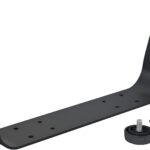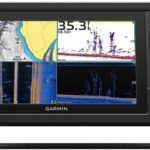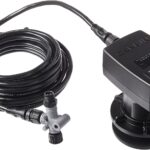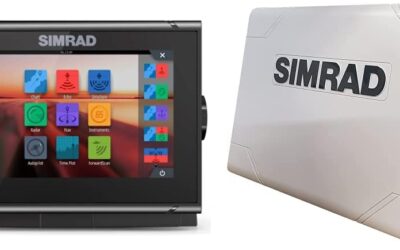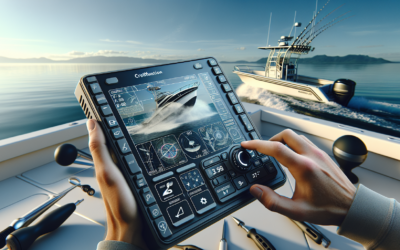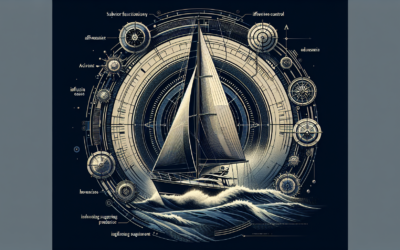If you’re an avid angler or a newbie fisherman, finding the right fish finder transducer for your needs can seem overwhelming. But fear not! In this article, we’ll break down the ins and outs of fish finder transducers and help you navigate through the vast sea of options. Whether you’re looking for a transducer for your boat or kayak, we’ve got you covered. From understanding the different types of transducers to deciphering the technical jargon, we’ll arm you with all the information you need to make an informed decision. So, let’s dive into the world of fish finder transducers and find the perfect match for your fishing adventures!
1. Understanding Fish Finder Transducers
1.1 What Is a Fish Finder Transducer?
A fish finder transducer is a crucial component of a fish finder device. It is responsible for sending and receiving sound waves in order to detect underwater objects, including fish, submerged structures, and the depth of the water. The transducer converts electrical signals from the fish finder into sound waves that are then transmitted into the water. When these sound waves encounter objects in the water, they bounce back to the transducer, which then converts them back into electrical signals that are interpreted and displayed on the fish finder screen.
1.2 Types of Fish Finder Transducers
Fish finder transducers come in different types, each with its own unique features and capabilities. It is important to understand these types in order to choose the right transducer for your fishing needs.
- Traditional Single-Frequency Transducers: These transducers operate at a single frequency, typically around 200 kHz. They are affordable and provide accurate depth readings, making them ideal for basic fishing applications in shallow waters.
- Dual-Frequency Transducers: Dual-frequency transducers operate at both low and high frequencies, usually around 50 kHz and 200 kHz. They offer a wider range of capabilities, providing better target separation and depth penetration. This makes them suitable for various fishing environments, including both shallow and deep waters.
- CHIRP Transducers: CHIRP (Compressed High-Intensity Radar Pulse) transducers emit a continuous range of frequencies, allowing for better target separation, enhanced clarity, and improved image detail. They are highly effective in different water conditions and depths, making them a popular choice among anglers.
- Side Imaging and Down Imaging Transducers: These transducers use specialized technology to create detailed, high-resolution images of the underwater environment. Side imaging transducers provide a wide view of the area to the sides of the boat, while down imaging transducers offer a more focused view directly below the boat. These transducers are especially useful for anglers looking to explore and locate specific structures or fish-holding areas.
2. Factors to Consider When Choosing a Fish Finder Transducer
2.1 Frequencies and Cone Angles
When choosing a fish finder transducer, it is important to consider the frequencies and cone angles that best suit your fishing needs. The frequency of a transducer determines its ability to penetrate different depths of water and provide accurate readings. Low frequencies (around 50 kHz) are ideal for deep-water fishing, as they offer greater depth penetration and wider coverage area. On the other hand, high frequencies (around 200 kHz) provide more detailed images and are better suited for shallow-water fishing.
The cone angle of a transducer refers to the width of the sonar beam it emits. A wider cone angle covers a larger area, making it suitable for scanning wide areas and detecting fish that are spread out. Conversely, a narrower cone angle provides a more focused beam, allowing for greater target separation and the ability to distinguish individual fish or structures.
2.2 Power and Depth Capability
Consider the power output and depth capability of a fish finder transducer to ensure it can meet your fishing requirements. Higher-powered transducers generally provide better performance, especially in deeper waters. If you plan to fish in deep ocean waters or target species that reside in deeper depths, a transducer with higher power output will be essential for accurate readings.
Depth capability refers to the maximum depth at which a transducer can accurately measure. It is important to choose a transducer that matches the depths you typically fish in. Transducers with a higher frequency can provide detailed images in shallow waters but may struggle to perform in deeper depths. Conversely, transducers with lower frequencies may be more suitable for deep-sea fishing but may sacrifice some image clarity in shallow waters.
2.3 Transducer Mounting Options and Compatibility
Consider the mounting options and compatibility of a fish finder transducer with your boat or kayak. Transducers can be mounted in different ways, such as through-hull, transom mount, or trolling motor mount. Each option has its own advantages and considerations, so it is important to choose the mounting style that suits your vessel and fishing style.
Additionally, ensure that the transducer you choose is compatible with your fish finder unit. Not all transducers work with all fish finder models, so it is crucial to check the compatibility before making a purchase. Consult your fish finder’s manufacturer or refer to the product specifications to ensure a proper fit.
3. Popular Fish Finder Transducer Technologies
3.1 Traditional Single-Frequency Transducers
Traditional single-frequency transducers are widely used and offer a cost-effective solution for basic fishing needs. They are renowned for their simplicity and reliability, providing accurate depth readings in shallow waters. These transducers are typically used by anglers who fish in lakes, rivers, and other freshwater environments where the water is not too deep. Although they lack some of the advanced features of other transducer types, they can still be highly effective for recreational fishing purposes.
3.2 Dual-Frequency Transducers
Dual-frequency transducers offer a versatile solution for a wide range of fishing conditions. By operating at both low and high frequencies, these transducers provide the best of both worlds. The low frequency (usually around 50 kHz) provides greater depth penetration, making it suitable for deep-sea fishing. The high frequency (around 200 kHz) offers better target separation and image detail, making it ideal for shallow-water fishing. With dual-frequency transducers, anglers can adapt to different fishing scenarios, from offshore trolling to nearshore casting.
3.3 CHIRP Transducers
CHIRP transducers have revolutionized fish finder technology with their advanced sonar capabilities. Instead of transmitting a single frequency, CHIRP transducers emit a continuous range of frequencies. This technique results in improved target separation, enhanced clarity, and better image detail compared to traditional single-frequency or dual-frequency transducers. The continuous range of frequencies also allows CHIRP transducers to adapt to varying water conditions and depths, making them highly effective in a wide range of fishing environments. Whether you are fishing in shallow waters or deep-sea fishing, CHIRP transducers can provide accurate and detailed sonar imaging.
3.4 Side Imaging and Down Imaging Transducers
Side imaging and down imaging transducers utilize specialized technology to create detailed images of the underwater environment. Side imaging transducers use a wide beam to scan horizontally to the sides of the boat, providing a comprehensive view of the area. This is particularly useful for locating underwater structures or determining the presence of fish-holding areas. On the other hand, down imaging transducers provide a more focused beam that scans directly below the boat, offering a more detailed view of the bottom and any fish or structures beneath it. These transducers are highly beneficial for anglers who require precise imaging or want to explore new fishing spots with greater clarity.
4. Single-Frequency Transducers
4.1 Overview
Single-frequency transducers are the simplest and most affordable option for anglers who prioritize accurate depth readings over advanced features. They operate at a single frequency, typically around 200 kHz, and are primarily used in freshwater environments with shallow depths. Single-frequency transducers are suitable for recreational anglers who fish in lakes, rivers, or other bodies of water where water depths are not too extreme.
4.2 Pros and Cons
Pros
- Affordability: Single-frequency transducers are generally more affordable than other types of transducers, making them a budget-friendly option for anglers.
- Accuracy: Due to their single-frequency operation, these transducers provide accurate depth readings, allowing anglers to monitor water depths with precision.
- Simplicity: Single-frequency transducers are easy to operate and require minimal setup. They offer a straightforward solution for anglers who prefer a simple fish finder setup.
Cons
- Limited Performance: Single-frequency transducers have limited capabilities in terms of imaging and target separation. Their single-frequency operation may not provide the level of detail and resolution found in more advanced transducers.
- Shallow-Water Use: These transducers are best suited for use in shallow waters, where their limited depth penetration is not a significant disadvantage.
- Lack of Advanced Features: Single-frequency transducers do not offer the advanced features found in other transducer types, such as CHIRP or side imaging capabilities. Anglers seeking more advanced functionality may find the limitations of single-frequency transducers restrictive.
5. Dual-Frequency Transducers
5.1 Overview
Dual-frequency transducers are a versatile option for anglers who fish in a variety of environments, from shallow to deep waters. These transducers operate at both low and high frequencies, typically around 50 kHz and 200 kHz, respectively. By utilizing two frequencies, dual-frequency transducers offer a wider range of capabilities compared to single-frequency transducers.
5.2 Pros and Cons
Pros
- Versatility: The dual-frequency operation of these transducers allows anglers to adapt to different fishing scenarios. The low frequency provides greater depth penetration, making them suitable for deep-sea fishing, while the high frequency offers better target separation and image detail in shallow waters.
- Target Separation: Dual-frequency transducers provide improved target separation compared to single-frequency transducers. This enables anglers to distinguish individual fish and structures more effectively.
- Depth Capability: These transducers offer a balance between depth penetration and resolution, making them suitable for a wide range of fishing depths.
Cons
- Higher Cost: Dual-frequency transducers are typically more expensive than single-frequency transducers due to their increased capabilities and versatility.
- Complicated Setup: Compared to single-frequency transducers, dual-frequency transducers may require more advanced setup and adjustment due to their dual-frequency operation. This may involve selecting the appropriate frequency for specific fishing conditions.
- Performance Trade-Offs: While dual-frequency transducers offer improved versatility, they may not provide the same level of imaging detail and resolution as more advanced transducer types, such as CHIRP or side imaging transducers.
6. CHIRP Transducers
6.1 Overview
CHIRP transducers represent the latest advancements in fish finder technology. Unlike traditional transducers that emit a single frequency, CHIRP transducers transmit a continuous range of frequencies. This results in enhanced target separation, improved clarity, and superior image detail compared to single-frequency or dual-frequency transducers.
6.2 Pros and Cons
Pros
- Enhanced Imaging: CHIRP transducers offer superior imaging capabilities, providing anglers with more detailed sonar images. The continuous range of frequencies allows for greater target separation, making it easier to distinguish individual fish and structures.
- Adaptability: CHIRP transducers can adapt to varying water conditions and depths, providing high-quality imaging regardless of the fishing environment. This makes them versatile options for anglers who fish in different locations and depths.
- Clarity and Resolution: The continuous frequency range of CHIRP transducers enhances image clarity and resolution, providing anglers with a more accurate representation of the underwater environment.
Cons
- Higher Cost: CHIRP transducers are typically more expensive than traditional single-frequency or dual-frequency transducers due to their advanced technology and improved performance.
- Technical Expertise: CHIRP transducers may require a greater level of technical expertise to set up and optimize. Adjusting the settings and frequencies to match specific fishing conditions may require some knowledge and understanding of the technology.
- Compatibility: Some older fish finder models may not be compatible with CHIRP transducers. It is important to ensure that your fish finder unit supports CHIRP technology before purchasing a CHIRP transducer.
7. Side Imaging and Down Imaging Transducers
7.1 Overview
Side imaging and down imaging transducers utilize specialized technology to provide detailed images of the underwater environment. These transducers are particularly beneficial for anglers looking to explore new fishing spots or locate specific fish-holding structures.
Side imaging transducers use a wide beam to scan horizontally to the sides of the boat, providing a comprehensive view of the area. This allows anglers to locate submerged structures, such as rocks, wrecks, or vegetation, as well as identify potential fish-holding areas. Side imaging transducers are highly effective for anglers who enjoy mapping out the underwater terrain of their fishing spot.
Down imaging transducers, on the other hand, provide a more focused beam that scans directly below the boat. This offers a detailed view of the bottom and any fish or structures beneath it. Down imaging transducers are particularly useful for anglers who require precision when identifying fish species, distinguishing between fish and other underwater objects, or targeting specific fish-holding structures.
7.2 Pros and Cons
Pros
- Detailed Imaging: Side imaging and down imaging transducers provide anglers with detailed and high-resolution images of the underwater environment. This allows for better visibility and identification of submerged structures and fish-holding areas.
- Exploration and Mapping: Side imaging transducers are especially beneficial for anglers who enjoy mapping out the underwater terrain and identifying potential hotspots for future fishing trips.
- Target Identification: Down imaging transducers offer a more focused beam, enabling anglers to identify specific fish species or distinguish between fish and other underwater objects with greater clarity.
Cons
- Higher Cost: Side imaging and down imaging transducers can be more expensive than traditional transducers due to their specialized imaging capabilities.
- Image Interpretation: The detailed images provided by these transducers may require some interpretation and understanding. Anglers need to familiarize themselves with the different structures and features that appear on the screen to effectively utilize this technology.
- Technical Expertise: Setting up and optimizing side imaging and down imaging transducers may require some technical expertise. Correct adjustment of settings and interpretation of the displayed images may take time and practice.
8. Selecting the Right Transducer for Your Fishing Style
8.1 Transducers for Freshwater Fishing
When it comes to freshwater fishing, the choice of transducer depends on the specific fishing style and the depth of the water. Traditional single-frequency transducers are usually sufficient for recreational fishing in lakes, rivers, and ponds with relatively shallow depths. These transducers offer accurate depth readings and are more budget-friendly.
For anglers seeking more versatility and capabilities, dual-frequency transducers are a suitable option. They provide better target separation and coverage, making them suitable for various freshwater environments. Whether fishing in shallow or deep waters, a dual-frequency transducer can adapt to different conditions and help locate different species of fish.
Anglers with a preference for exploring and mapping out the underwater terrain of their fishing spot may opt for side imaging transducers. These transducers offer a wide view of the area to the sides of the boat, helping anglers locate submerged structures and potential fish-holding areas.
8.2 Transducers for Saltwater Fishing
Saltwater fishing often involves fishing in deeper waters and facing more challenging conditions. Therefore, the choice of transducer for saltwater fishing should prioritize depth capability and target separation.
Dual-frequency transducers are a popular choice for saltwater fishing due to their ability to provide greater depth penetration while still offering good target separation and imaging capabilities. They allow anglers to explore deeper areas and target various saltwater species.
CHIRP transducers are also highly recommended for saltwater fishing due to their adaptability and enhanced imaging capabilities. The continuous range of frequencies provided by CHIRP transducers ensures accurate and detailed sonar images in saltwater environments, even in challenging conditions such as strong currents or murky waters.
8.3 Transducers for Ice Fishing
Ice fishing presents unique challenges that require specialized transducers. Due to the limited view beneath the ice, ice fishing transducers should be able to provide a wide coverage area and accurate readings, even in extreme cold conditions.
Ice fishing transducers are typically designed to be portable and easy to install on the ice, as well as providing reliable performance in freezing temperatures. Dual-frequency transducers with wider cone angles are commonly used for ice fishing, as they offer a broad coverage area and greater detection capability under the ice.
Some ice fishing transducers also feature specialized displays that are designed to be easily readable in bright sunlight or low-light conditions. This ensures anglers can clearly see the fish finder readings on the ice.
8.4 Transducers for Kayak Fishing
For kayak fishing, transducer selection should prioritize portability, ease of installation, and compatibility with kayak mounting options. Transducers that can be easily installed on the kayak, such as transom mount or kayak-specific mounting kits, are ideal for kayak anglers.
Dual-frequency transducers with a wide cone angle are suitable for kayak fishing, as they provide better coverage and target separation in various fishing environments. Kayak anglers may also opt for CHIRP transducers if they want superior imaging capabilities and adaptability to different water conditions and depths.
It is important to choose a transducer that is specifically designed for kayak fishing or one that can be easily adapted to fit on a kayak. Consider the size and weight of the transducer to ensure it is compatible with the dimensions and load capacity of the kayak.
9. Transducer Installation Tips and Best Practices
9.1 Mounting Options and Location
Proper transducer installation is crucial for optimal performance. The mounting option and location of the transducer can significantly impact its effectiveness. Transducers can be mounted in various ways, including through-hull, transom mount, or trolling motor mount.
Transom mount is the most common mounting option and is suitable for most fishing applications. It involves attaching the transducer to the transom or the bottom rear of the boat. Make sure to follow the manufacturer’s instructions for installation, including maintaining a proper angle and ensuring a secure and stable mounting.
Through-hull transducer installation requires drilling a hole through the hull of the boat. This option provides a clean and streamlined look, while also minimizing potential interference. It is important to choose the appropriate location and ensure a watertight seal to prevent leaks.
Trolling motor mount transducers are specifically designed for mounting onto trolling motors. They offer the advantage of providing sonar readings as the angler moves around the fishing spot. This option is particularly beneficial for anglers who frequently move or fish from a trolling motor-equipped vessel.
When determining the mounting location, consider the depth of the water, the angle of the transducer, and any potential obstructions that may obstruct the sonar signal. Avoid mounting the transducer near objects that may cause turbulence or cavitation, such as struts, propellers, or other onboard equipment.
9.2 Adjusting Transducer Angle
Proper transducer angle adjustment is essential for accurate readings. The angle should be adjusted to ensure optimal sonar performance, target separation, and image quality. Anglers should consult the manufacturer’s instructions for the recommended angle adjustment specific to their transducer model.
In general, transducers should be angled slightly downward, with the rear slightly higher than the front. This allows the sonar beam to travel deeper into the water column. The recommended angle may vary based on the fishing environment and the desired coverage area. Experimenting with different angles and observing the sonar readings can help anglers determine the best angle for their fishing style.
Once the transducer is mounted, secure it tightly to prevent any movement caused by boat vibration or water turbulence. Loose or misaligned transducers can result in inaccurate readings or signal loss.
9.3 Connection and Wiring
Proper transducer wiring and connection are essential for reliable performance and accurate readings. Follow the manufacturer’s instructions for connecting the transducer to the fish finder unit, as each model may have specific wiring requirements.
Ensure that the wiring is securely connected and properly sealed to prevent water intrusion. Many transducer cables are designed to be submerged in water, but it is important to use proper waterproof connections and seals when connecting the transducer cable to the fish finder unit. This will help prevent damage and ensure a reliable signal transmission.
To avoid potential interference, keep the transducer wiring separate from other power cables and avoid any sharp bends or kinks that could damage the wiring. Secure the wiring along the boat’s routing channels or use cable ties to keep it tidy and prevent tangling or snagging.
10. Troubleshooting Common Transducer Issues
10.1 Interference and Noise
Interference and noise can affect the performance of a fish finder transducer and result in inaccurate readings or loss of signal. Common sources of interference include electrical devices, other fish finder systems operating on the same frequency, and water turbulence.
To minimize interference, keep the fish finder unit’s power cables and transducer wiring separate from other electrical cables on the boat. Avoid routing the transducer wiring near powerful electrical equipment or motors that may generate electromagnetic interference.
If encountering interference from other nearby fish finder systems, try adjusting the frequency settings on the fish finder unit to avoid overlapping signals. Consult the fish finder unit’s manual or contact the manufacturer for guidance on adjusting the frequency.
Water turbulence caused by propellers, wake, or air bubbles can also create interference. Adjusting the transducer angle or relocating the transducer to an area with less turbulence can help minimize this issue.
10.2 False Readings and Loss of Signal
False readings and loss of signal are frustrating issues that can occur with fish finder transducers. False readings may appear as unidentifiable shapes or clutter on the screen, while loss of signal results in no readings or intermittent readings.
False readings can be caused by debris, seaweed, or air bubbles interfering with the sonar beam. Adjusting the sensitivity settings on the fish finder unit can help reduce false readings by filtering out weaker signals. Additionally, adjusting the transducer angle or increasing the depth range setting can help minimize false readings caused by nearby surface clutter.
Loss of signal can occur when the transducer loses contact with the water or when there is a problem with the transducer connection or wiring. Check the transducer mounting and ensure it is securely attached and properly aligned. Inspect the transducer cable and connectors for any signs of damage or water intrusion. If necessary, reseal or repair any damaged or compromised parts.
10.3 Cleaning and Maintenance
Regular cleaning and maintenance of the transducer can help ensure optimal performance and longevity. Remove any accumulated debris, algae, or marine growth from the transducer’s face using a soft brush or cloth. Avoid using harsh chemicals or abrasive materials that could damage the transducer surface.
Inspect the transducer cable regularly for any signs of wear or damage. Secure any loose connections or replace damaged cables to prevent signal loss or interference.
Consider applying a protective coating to the transducer face to prevent the buildup of marine growth and extend the lifespan of the transducer. There are specialized coatings available that can help minimize the need for frequent cleaning and maintenance.
By following these troubleshooting tips and practicing regular cleaning and maintenance, anglers can prolong the lifespan of their transducer and ensure reliable and accurate sonar readings.

